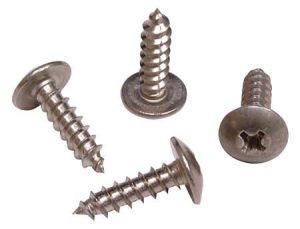
Sheet metal screws are commonly used in the aerospace manufacturing industry. Most airplanes contain few or no wooden parts. Instead, they are made of metal parts. Sheet metal screws are used to fasten these metal parts. While wood screws are designed for wooden parts, sheet metal screws are designed for metal parts, specifically those made of sheet metal.
#1) Strong Material
Sheet metal screws are made of a strong material. After all, they must be able to drive into sheet metal without breaking. You can find sheet metal screws in carbon steel. Carbon steel is an iron alloy with a high concentration of carbon. While carbon is susceptible to corrosion, it’s incredibly strong. In addition to carbon steel, sheet metal screws are avalable in titanium. Titanium is up to four times stronger than stainless steel, making it an excellent material for sheet metal screws.
#2) Narrow Threading
When compared to wood screws, sheet metal screws typically have narrower threading. Threading consists of the grooves that run along the shank. In wood screws, the threading is spaced farther apart. In sheet metal screws, the threading is spaced closer together. Narrow threading is a common characteristic of most sheet metal screws.
#3) Fully Threaded Shank
You typically won’t find sheet metal screws with a partially threaded shank. Rather, nearly all sheet metal screws have a fully threaded shank. The shank, of course, is the body of a screw. To install a screw, you’ll have to drive the shank into the object (or sheet metal). Sheet metal screws almost always have a fully threaded shank. The threading runs from the tip of a sheet metal screw all the way to the head. Wood screws, in comparison, may have a fully threaded shank or a partially threaded shank.
#4) Self-Tapping
Another common feature of sheet metal screws is self-tapping. Many sheet metal screws have a pointed tip that allows them to tap their hole. When you drive a sheet metal screw into a metal workpiece, it will tap a hole in the workpiece. In other words, it will create internal threading.
Other types are screws typically aren’t self-tapping. They can’t tap their own role. Rather, you’ll have to manually tap a hole in the workpiece before using them. Sheet metal screws are different in the sense that they can tap their own hole.
In Conclusion
You can often distinguish between sheet metal screws and other types of screws by looking for a few characteritics. Most sheet metal screws are made of a storng material, have narrow threading, feature a fully threaded shank and are self-tapping.



